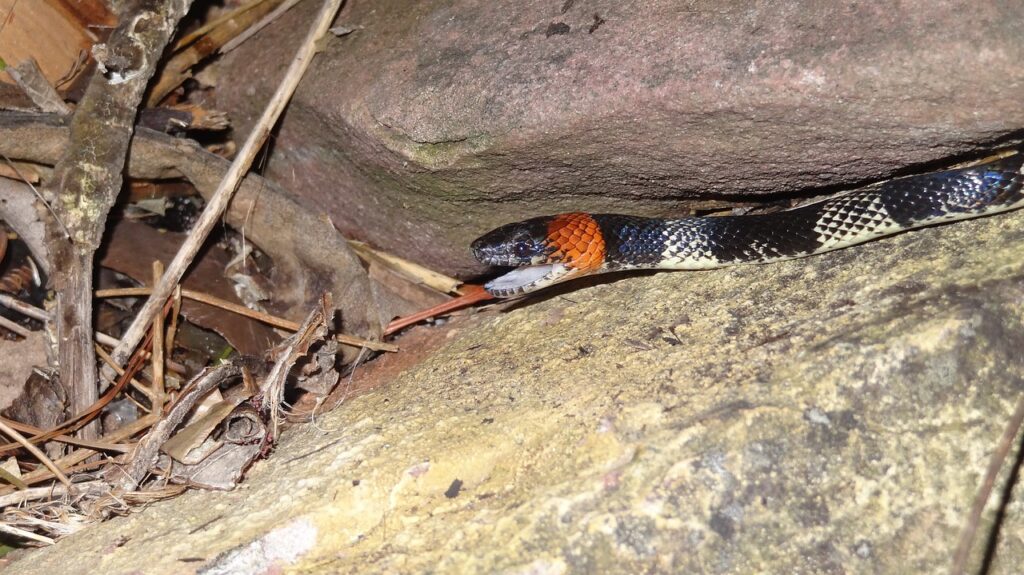Corn snakes (Pantherophis guttatus), known for their vibrant colors and docile nature, have become increasingly popular as captivating reptile companions. These snakes exhibit stunning color morphs and patterns that intrigue reptile enthusiasts and novices alike. This comprehensive guide delves into the fascinating world of corn snakes and explores various color varieties, including lavender, albino, blue, and palmetto. Additionally, we’ll discuss essential care guidelines for ensuring these captivating serpents thrive in captivity.

Image:- JoelAmaya https://commons.wikimedia.org/wiki/File:Roatan_Coral_Snake_(Micrurus_ruatanus).jpg
The Alluring Beauty of Lavender Corn Snakes
Lavender corn snakes are a sight to behold, boasting a soft, pastel hue that sets them apart from their counterparts. This captivating coloration results from a genetic mutation that affects pigmentation. Lavender corn snakes retain their gorgeous color throughout their lives, making them popular among snake enthusiasts. When caring for lavender corn snakes, it’s essential to maintain appropriate temperatures and provide a secure habitat for climbing and hiding.
Dazzling Elegance: Albino Corn Snakes
Albino corn snakes exhibit a mesmerizing lack of melanin, resulting in their signature red eyes and pale, creamy bodies. This stunning color morph is achieved through a recessive genetic trait. When caring for albino corn snakes, attention to lighting and avoiding direct sunlight is crucial due to their sensitivity to UV rays. Proper heating, humidity, and a balanced diet will contribute to the well-being of these captivating reptiles.
Mesmerizing Hues of Blue Corn Snakes: Blue corn snakes captivate with their striking blue hues, ranging from sky blue to deep indigo. The unique coloration of blue corn snakes results from genetic interactions that affect pigments. Maintaining consistent temperatures and providing a well-balanced diet is essential to ensure the health of blue corn snakes. Owners of blue corn snakes often enjoy observing their snake’s color changes as they shed.
Unique Palmetto Corn Snakes
Palmetto corn snakes showcase a distinctive pattern resembling the fronds of a palmetto tree. This captivating morph results from various genetic factors interacting to produce a unique design. Palmetto corn snakes require a secure and appropriately sized enclosure that allows them to explore and climb. Providing a variety of hiding spots and suitable substrate contributes to their overall well-being.
Understanding Corn Snake Lifespan and Care
Corn snakes have an average lifespan of 5-10 years in the wild, while those in captivity can live well into their teens and even early twenties with proper care. Factors influencing lifespan include genetics, diet, habitat conditions, and overall care. Owners should ensure suitable enclosure dimensions, temperature gradients, and humidity levels. A balanced diet of appropriately sized prey items is vital for maintaining their health.
Welcoming Baby Corn Snakes into Your Home
Raising baby corn snakes can be a rewarding experience. When selecting a baby corn snake, look for alertness, clear eyes, and a healthy body. Housing should include an appropriately sized enclosure with an appropriate substrate, temperature gradients, and hiding spots. Baby corn snakes typically start with pinky mice as their primary food source, gradually moving on to larger prey as they grow.
Corn Snakes in Florida
Native and Captive Varieties: Florida is home to native corn snake species, including the Eastern Corn Snake (Pantherophis guttatus) and the Scarlet Snake (Cemophora coccinea). The state’s warm climate has also contributed to the popularity of captive corn snakes as pets. Potential corn snake owners in Florida should know local regulations and consider adopting from reputable breeders. Engaging with local herpetological societies and conservation groups can provide valuable insights into the care and conservation of these fascinating reptiles.
Conclusion:
Corn snakes, with their remarkable color variations and charming personalities, offer a captivating glimpse into the world of reptile keeping. By understanding the distinct characteristics and care requirements of different color morphs, enthusiasts can embark on a fulfilling journey of caring for these remarkable serpents. Whether you’re drawn to the soothing lavender, the ethereal albinos, the captivating blues, or the unique patterns of palmetto corn snakes, one thing is sure: the world of corn snakes is as diverse and vibrant as the snakes themselves.
FAQs About Coral Snakes
Are coral snakes aggressive?
Coral snakes are not aggressive and will typically avoid human interaction. Bites are rare and usually occur when the snake feels threatened.
What should I do if I encounter a coral snake?
If you encounter a coral snake in the wild, admire it from a safe distance and do not attempt to handle it. Keep children and pets away as well.
Do all coral snakes follow the “red touches yellow” rhyme?
While the rhyme is a helpful guideline for many coral snake species, it may not apply to all subspecies. It’s best to avoid close contact with any brightly colored snake.
Can I keep a coral snake as a pet?
Keeping a coral snake as a pet is not recommended for inexperienced reptile keepers. They have specific care requirements and should only be handled by experts.
Are there any non-venomous snakes that mimic coral snakes?
Yes, some non-venomous snakes, such as scarlet king snakes, mimic the color patterns of coral snakes. Remember, it’s always safer to assume any brightly colored snake is venomous.

